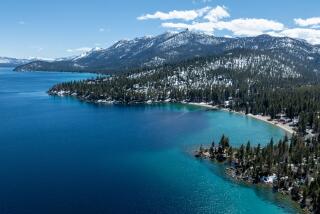Controls on Development Urged : Lake Tahoe--From Blue to Algae Green Foreseen
- Share via
Unbridled development will transform Lake Tahoe, one of the world’s most transparent lakes, from deep blue to algae green in the next 40 years, a researcher warned in a speech at UCLA Friday.
Construction of condominiums, ski resorts and pleasure-boat marinas around the lake on the Nevada-California border have stripped vegetation vital to the area’s sensitive ecology, said Dr. Charles R. Goldman, director of a research group studying Lake Tahoe.
“Tahoe really is being polluted and changed quite rapidly,” said Goldman, an expert on fresh water technology who teaches at UC Davis. “If we’re going to maintain it anywhere near its current condition some drastic changes are going to have to be made in its management.”
Proposals Offered
He proposed controls on local construction and fertilizer use and the replanting of surrounding vegetation, saying these remedies would eventually allow the lake to return to its clear-blue state.
Goldman began studying the nearly 1,700-foot-deep lake in 1958. In 1979 he took a mini-submarine 1,000 feet into its dark blue waters.
“We’re losing more than a foot of transparency a year,” he said.
Goldman warned that algae growth threatens the clarity of the lake.
Growth of Algae
He said that under good conditions a stone can be seen more than 100 feet below the surface, but added that “nutrient pollution,” the run-off of land-based nutrients into the lake has been stimulating the growth of algae in recent years.
Goldman said construction in recent years has stripped the soil of vegetation that normally would prevent the nutrients from seeping into the lake, nurturing algae already there.
A small amount of water naturally flowing into the lake has kept Tahoe relatively sterile and algae-free for the last 10,000 years, he said.
He predicted the lake would turn from clear blue to algae green within 40 years unless current construction is brought under control.
Population at 80,000
The population around Lake Tahoe in 1960 was fewer than 20,000 people. It has since climbed to more than 80,000.
Overflow from septic tanks, fertilizer that seeps from lawns and golf courses have also contributed to the growth of algae that floats to the top of the water and “piles up on shores as decaying scum,” Goldman said.
“As you get into the area of developed condominiums along the shore you find more algae,” he said.
“It’s hard to get the plants back but it’s the only way to get Lake Tahoe back,” he said. “I think it’s worth saving because it’s such an incredibly beautiful lake still.”
In 1969, the governors of Nevada and California created the Tahoe Regional Planing Agency to bring order to the area’s growth. But the agency has been plagued by fights between environmentalists who want to stop or restrict growth and by developers and landowners who want more growth.
More to Read
Sign up for Essential California
The most important California stories and recommendations in your inbox every morning.
You may occasionally receive promotional content from the Los Angeles Times.













